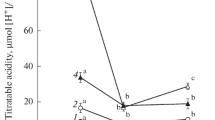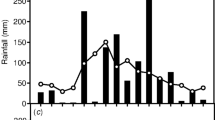Abstract
Preceding results, based on the determination of stable carbon isotope composition (δ13C) of leaf tissues from various Kalanchoë species, suggested a close coincidence between the photosynthetic flexibility of the species and their habitat, life form and taxonomic position within the genus. The ability to shift from C3-to Crassulacean Acid Metabolism (CAM)-type of photosynthesis seemed to concern in particular the more ancestral species in the genus and to be linked to epiphytism and changing climatic situations. For deeper insights into these interrelationships, physiological studies in controlled conditions were carried out on K. miniata and K. porphyrocalyx. These two species differ by their habitat preference and life form. Measurements were conducted on CO2 exchange patterns, day/night fluctuation of malate content in the leaves and ‘capacity’ of phosphoenolpyruvate carboxylase (PEPC). The results show that the 2 species can be considered as ‘facultative’ CAM plants, with very high flexibility in their photosynthetic behaviour. The decrease in water availability seems to be a major factor triggering the shift from C3 to the CAM mode. In K. miniata, 21 days of drought depressed CO2 uptake to the level of CAM idling whereas in K. porphyrocalyx, CO2 exchange was considerably more resistant. At least for K. miniata, short-day treatment was found to be a further CAM-inducing factor. The results are discussed in terms of their ecophysiological significance under the environmental conditions of the sites where the investigated species naturally grow.
Similar content being viewed by others
References
Boiteau, P and Allorge-Boiteau, L (1995) Kalanchoë (Crassulacées de Madagascar): systématique, écophysiologie et phytochimie. Kartala, Paris
Brulfert J, Ravelomanana D and Kluge M (1995) Ecophysiologie des Kalanchoë. Le métabolisme acide des Crassulacées (CAM); Une voie photosynthétique adaptative. In: Kalanchoë (Crassulacées de Madagascar): sytématique, écophysiologie et phytochimie, pp 207–218 Kartala, Paris
Brulfert J, Kluge M, Güçlü S and Queiroz O (1988) Interaction of photoperiod and drought as CAM inducing factors in Kalanchoe blossfeldiana Poelln, cv Tom Thumb. J Plant Physiol 133: 222–227
Brulfert J, Müller D, Kluge M and Queiroz O (1982) Photoperiodism and crassulacean acid metabolism. I: Immunological and kinetic evidences for different patterns of phosphoenolpyruvate carboxylase isoforms in photoperiodically inducible and non-inducible CAM plants. Planta 154: 326–331
Goh CJ and Kluge M (1989) Gas exchange and water relations in epiphytic orchids. In: Lüttge U (ed) Vascular Plants as Epiphytes. Ecological Studies, Vol 76, pp 139–166, Springer-Verlag, Berlin, Heidelberg, New York
Gregory FG, Spear J and Thimann HV (1954) The interrelation between CO2 metabolism and photoperiodism in Kalanchoe. Plant Physiol 29: 220–229
Kluge M and Brulfert J 1995 Crassulacean Acid Metabolism in the genus Kalanchoe: Ecological, physiological and biochemical aspects. In: Winter K and Smith JAC (eds) Crassulacean Acid Metabolism: Biochemistry, Ecophysiology and Evolution. Ecological Studies, Vol 114, pp 324–335. Springer-Verlag, Berlin, Heidelberg, New York
Kluge M and Ting IP (eds) (1978) Crassulacean Acid Metabolism: Analysis of an Ecological Adaptation. Ecological Studies, Vol 30. Springer-Verlag, Berlin, Heidelberg, New York
Kluge M, Brulfert J, Lipp J, Ravelomanana D and Ziegler H (1993) A comparative study by δ13C-analysis of Crassulacean Acid Metabolism (CAM) in Kalanchoë (Crassulaceae), species of Africa and Madagascar. Bot Acta 106: 320–324
Kluge M, Brulfert J, Ravelomanana D, Lipp J and Ziegler H (1991) Crassulacean Acid Metabolism in Kalanchoe species collected in various climatic zones of Madagascar: A survey by δ13C analysis. Oecologia 88: 407–414
Kluge M, Razanoelisoa B, Ravelomanana D and Brulfert J (1992) In situ studies of Crassulacean Acid Metabolism in Kalanchoe beharensis Drake Del Castillo, a plant of the semi-arid southern region of Madagascar. New Phytol 120: 323–334
Lüttge U (1987) Carbon dioxide and water demand: Crassulacean acid metabolism (CAM), a versatile ecological adaptation exemplifying the need for integration in ecophysiological work. New Phytol 106: 593–629
Lüttge U, Kluge M and Ball E (1975) Effects of osmotic gradients on vacuolar malic acid storage. A basic principle in oscillatory behaviour of Crassulacean Acid Metabolism. Plant Physiol 56: 613–616
Osmond B (1978) Crassulacean Acid Metabolism: A curiosity in context. Annu Rev Plant Physiol 29: 379–414
Queiroz O and Brulfert J (1982) Photoperiod-controlled of induction or enhancement of seasonal adaptation to drought. In: Ting IP and Gibbs M (eds) Crassulacean Acid Metabolism, pp 208–230. Am Soc Plant Physiol, Rockville, MD
Ravelomanana D (1993) Ecophysiologie des Kalanchoë de Madagascar: Le métabolisme acide des Crassulacées (CAM) en tant que processus physiologique adaptatif. Thèse Doc. Etat Université de Antananarivo, Madagascar
Szarek SR and Ting IP (1975) Physiological responses to rainfall in Opuntia basilaris. Plant Physiol 52: 539–541
Winter K (1985) Crassulacean Acid Metabolism. In: Barber J and Barber NR (eds) Photosynthetic Mechanisms and the Environment, pp 330–387. Elsevier Science Publishers, New York
Author information
Authors and Affiliations
Rights and permissions
About this article
Cite this article
Brulfert, J., Ravelomanana, D., Güçlü, S. et al. Ecophysiological studies in Kalanchoë porphyrocalyx (Baker) and K. miniata (Hils et Bojer), two species performing highly flexible CAM. Photosynth Res 49, 29–36 (1996). https://doi.org/10.1007/BF00029425
Received:
Accepted:
Issue Date:
DOI: https://doi.org/10.1007/BF00029425




